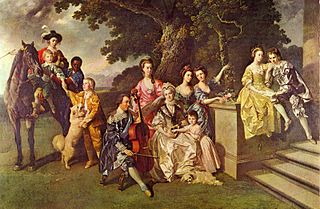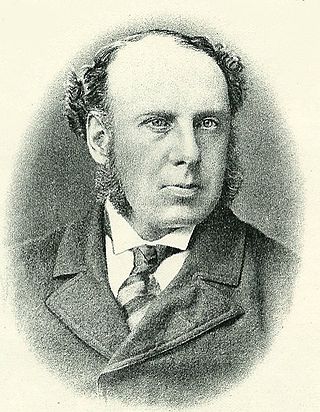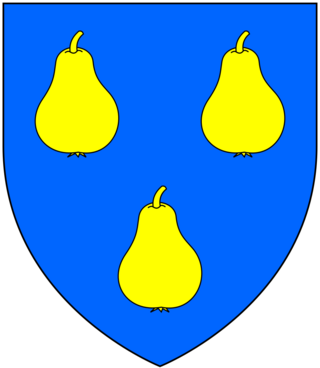Baron Killearn, of Killearn in the County of Stirling, is a title in the Peerage of the United Kingdom. It was created in 1943 for the diplomat Sir Miles Lampson. He was the second son of Norman Lampson, youngest son of Sir Curtis Lampson, 1st Baronet, of Rowfant. Lord Killearn's eldest son, the second Baron, succeeded his second cousin once removed as fourth Baronet in 1971. On his death the titles passed to his half-brother, the third and present holder of the barony and baronetcy.
Sir Basil Edward Peto, 1st Baronet was a British businessman and Unionist politician.
There have been four baronetcies created for persons with the surname Leslie, one in the Baronetage of Nova Scotia, one in the Baronetage of Ireland, one in the Baronetage of Great Britain and one in the Baronetage of the United Kingdom. Three of the creations are extant as of 2010.
The Hill-Wood Baronetcy, of Moorfield in the Parish of Glossop in the County of Derby, is a title in the Baronetage of the United Kingdom. It was created on 25 January 1921 for the businessman and Conservative MP for High Peak, Derbyshire for 19 years, Samuel Hill-Wood. Born Samuel Wood, he was the only son of Samuel Wood, a wealthy cotton manufacturer. He had assumed before the title's creation in 1912 by royal licence the additional surname of Hill, the maiden name of his grandmother Alice, daughter of John Hill, of Liverpool His male-line descendants have continued with this surname.

There have been five baronetcies created for persons with the surname Young, one in the Baronetage of England, one in the Baronetage of Great Britain and three in the Baronetage of the United Kingdom. As of 2014, four of the creations are extant.
There have been two baronetcies created for members of the Ropner family, both in the Baronetage of the United Kingdom. Both creations are still extant. The Ropner family is of German descent.
The Mott Baronetcy, of Ditchling in the County of Sussex, is a title in the Baronetage of the United Kingdom. It was created on 25 June 1930 for the noted engineer Basil Mott.
There have been four baronetcies created for persons with the surname Hall, one in the Baronetage of Nova Scotia and three in the Baronetage of the United Kingdom. Three of the creations are extant as of 2010.
There have been four baronetcies created for persons with the surname Barlow, one in the Baronetage of England and three in the Baronetage of the United Kingdom.
There have been three baronetcies created for persons with the surname Noble, all in the Baronetage of the United Kingdom.
There have been eight baronetcies created for persons with the surname Jackson, one in the Baronetage of England, one in the Baronetage of Great Britain and six in the Baronetage of the United Kingdom. As of 2014 four of the creations are extant.
There have been seven baronetcies created for persons with the surname Edwards, three in the Baronetage of England and four in the Baronetage of the United Kingdom. Only one creation is extant as of 2007.

There have been two baronetcies created for persons with the surname Lucas: one in the Baronetage of England and one in the Baronetage of the United Kingdom.

There have been two baronetcies created for persons with the surname Houldsworth, both in the Baronetage of the United Kingdom. One creation is extant as of 2007.
There have been six baronetcies created for persons with the surname King, one in the Baronetage of Ireland, one in the Baronetage of Great Britain and four in the Baronetage of the United Kingdom. Three of the creations are extant as of 2007.
There have been four baronetcies created for persons with the surname Morris, all in the Baronetage of the United Kingdom. As of 2014 two of the creations are extant.

The Stucley Baronetcy, of Affeton Castle in the County of Devon, is a title in the Baronetage of the United Kingdom. It was created on 26 April 1859 for George Stucley, Conservative Member of Parliament for Barnstaple from 1855 to 1857. Born George Stucley Buck, he had assumed by Royal licence the surname of Stucley in lieu of his patronymic, on the death of his father, in 1858 as lineal representative of the ancient Stucley family. This family, which possessed Affeton Castle in Devon for over 600 years, originally came from the village of Stukeley in Huntingdonshire, and were sheriffs of that county during the reign of King John. The family are descended from Richard Stucley, of Trent, Somerset, and Elizabeth Fitzroger his wife. Their son, Hugh Stucley married Katherine Affeton, heiress of the Affeton estates, and was sheriff of Devon in 1448. The fifth Baronet served as a Deputy Lieutenant and High Sheriff of Devon.

The Ferguson Davie Baronetcy, of Creedy in the County of Devon, is a title in the Baronetage of the United Kingdom. It was created on 9 January 1847 for Henry Ferguson Davie, a General in the Army and Member of Parliament for Haddington from 1847 to 1878. Born Henry Ferguson, he was the husband of Frances Juliana Davie, only surviving sister of Sir John Davie, 9th Baronet, of Creedy, and niece and heiress of Sir Humphrey Davie, 10th Baronet, of Creedy. In 1846 he assumed by Royal licence the additional surname of Davie. The second Baronet represented Barnstaple in the House of Commons as a Liberal.

The Keane Baronetcy, of Belmont in the County of Waterford, is a title in the Baronetage of the United Kingdom. It was created on 1 August 1801 for John Keane, Member of Parliament for Youghal from 1801 to 1806 and from 1808 to 1818. He had earlier represented Bangor in the Irish House of Commons. The second Baronet was Whig Member of Parliament for County Waterford between 1832 and 1835. The third Baronet served as high sheriff of County Waterford in 1856 and the fourth Baronet in 1881. The fifth Baronet was a Senator of the Irish Free State and Governor of the Bank of Ireland. The sixth Baronet, Sir Richard Keane, excelled in the military and also worked in 1930s as a diplomatic correspondent for The Times newspaper. Sir Richard Keane was also partly responsible for bringing the Military and Hospitaller Order of St. Lazarus of Jerusalem to Ireland in 1962 and was a Knight of St. Lazarus. As of 2014 the title is held by his son, the seventh Baronet, who succeeded in 2010.
There have been three baronetcies created for members of the Farquhar family, one in the Baronetage of Great Britain and two in the Baronetage of the United Kingdom. One creation is extant as of 2008.







